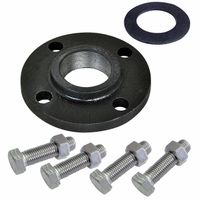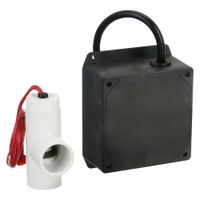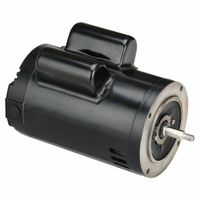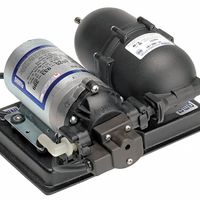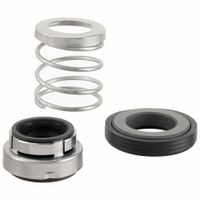Call +(254) 703 030 000 / 751 483 999 / 721 704 777
.....Read More
Frequently Asked Questions
What is the difference between horizontal and vertical booster pumps?
Horizontal booster pumps are designed with the pump shaft positioned horizontally. They are typically used in applications where space is not a constraint, as they require more floor space for installation. These pumps are easier to maintain because their components are more accessible. Horizontal pumps are often used in industrial settings for boosting water pressure in large systems, and they can handle a wide range of flow rates and pressures.
Vertical booster pumps, on the other hand, have the pump shaft oriented vertically. They are ideal for applications where floor space is limited, as they have a smaller footprint compared to horizontal pumps. Vertical pumps are often used in high-rise buildings or areas with limited space. They are also preferred in situations where the suction head is limited, as they can be installed directly over the water source, reducing the need for extensive piping.
In terms of performance, horizontal pumps generally offer better efficiency and are capable of handling higher flow rates. Vertical pumps, however, are better suited for high-pressure applications and can be more efficient in terms of energy consumption when space constraints are a factor.
The choice between horizontal and vertical booster pumps depends on factors such as available space, required flow rate, pressure needs, and maintenance considerations. Each type has its own advantages and is suited to specific applications, making it important to assess the requirements of the system before selecting the appropriate pump type.
How do constant pressure booster pumps work?
Constant pressure booster pumps work by maintaining a steady water pressure in a plumbing system, regardless of varying demand. They are typically used in residential, commercial, or industrial settings where water pressure needs to be consistent, such as in high-rise buildings or areas with low municipal water pressure.
The system consists of a pump, a pressure sensor, and a controller. The pump is responsible for moving water from the source to the desired location. The pressure sensor continuously monitors the water pressure in the system. When the pressure drops below a predetermined set point, the sensor sends a signal to the controller.
The controller, which acts as the brain of the system, receives the signal from the pressure sensor and activates the pump. The pump then increases the water flow to raise the pressure back to the desired level. Once the pressure reaches the set point, the sensor detects this change and signals the controller to turn off the pump, preventing over-pressurization.
Some advanced systems use variable frequency drives (VFDs) to adjust the pump's speed, allowing for more precise control of the water pressure. This not only ensures a constant pressure but also improves energy efficiency by reducing the pump's speed when full capacity is not needed.
In summary, constant pressure booster pumps maintain a stable water pressure by using a combination of sensors, controllers, and pumps. They automatically adjust the pump operation based on real-time pressure readings, ensuring consistent water delivery and enhancing the efficiency and reliability of the water supply system.
What are the benefits of using booster pumps in water supply systems?
Booster pumps in water supply systems offer several benefits:
1. **Increased Water Pressure**: Booster pumps enhance water pressure, ensuring consistent and adequate flow, especially in high-rise buildings or areas with low natural pressure.
2. **Improved Water Flow**: They help maintain a steady flow rate, crucial for residential, commercial, and industrial applications, ensuring efficient operation of appliances and machinery.
3. **Enhanced System Efficiency**: By optimizing pressure, booster pumps reduce the workload on the main pump, leading to energy savings and prolonged equipment life.
4. **Versatility**: Suitable for various applications, booster pumps can be used in municipal water systems, irrigation, and fire protection systems, adapting to different pressure requirements.
5. **Reliability**: They provide a reliable solution for overcoming pressure drops due to elevation changes or long-distance water transport, ensuring consistent water delivery.
6. **Customization**: Booster pumps can be tailored to specific needs, with options for variable speed drives and pressure settings, allowing for precise control over water pressure and flow.
7. **Cost-Effectiveness**: By improving system efficiency and reducing energy consumption, booster pumps can lead to lower operational costs over time.
8. **Space-Saving**: Compact designs allow for easy installation in confined spaces, making them ideal for retrofitting existing systems without extensive modifications.
9. **Reduced Maintenance**: Modern booster pumps are designed for durability and require minimal maintenance, reducing downtime and associated costs.
10. **Environmental Benefits**: By optimizing water usage and reducing energy consumption, booster pumps contribute to more sustainable water management practices.
Overall, booster pumps are essential for ensuring efficient, reliable, and cost-effective water supply in various settings, addressing both pressure and flow challenges.
How do you maintain a booster pump?
To maintain a booster pump effectively, follow these steps:
1. **Regular Inspection**: Conduct routine visual inspections for leaks, unusual noises, or vibrations. Check for any signs of wear or damage on the pump and its components.
2. **Lubrication**: Ensure that all moving parts are properly lubricated according to the manufacturer's specifications. Use the recommended type and amount of lubricant to prevent friction and wear.
3. **Check Pressure Settings**: Regularly verify that the pressure settings are within the desired range. Adjust the pressure switch if necessary to maintain optimal performance.
4. **Clean Filters and Strainers**: Inspect and clean the inlet filters and strainers to prevent blockages that can reduce efficiency and cause damage. Replace them if they are worn out or damaged.
5. **Monitor Electrical Components**: Check the electrical connections for any signs of corrosion or loose wires. Ensure that the motor is functioning correctly and that the control panel is operating as expected.
6. **Inspect Seals and Gaskets**: Examine seals and gaskets for any signs of leakage or deterioration. Replace them if they are compromised to prevent water leakage and maintain pressure.
7. **Test Safety Devices**: Regularly test safety devices such as pressure relief valves to ensure they are functioning correctly and providing the necessary protection.
8. **Record Maintenance Activities**: Keep a detailed log of all maintenance activities, including inspections, repairs, and replacements. This helps in tracking the pump's performance and scheduling future maintenance.
9. **Professional Servicing**: Schedule periodic professional servicing to address complex issues and ensure that the pump is in optimal condition.
10. **Follow Manufacturer Guidelines**: Adhere to the maintenance schedule and guidelines provided by the manufacturer to ensure the longevity and efficiency of the booster pump.
What are the common applications of booster pumps?
Booster pumps are widely used across various industries and applications to increase the pressure of fluids, ensuring efficient flow and distribution. Here are some common applications:
1. **Residential Water Supply**: In homes, booster pumps are used to increase water pressure from municipal supply lines, especially in multi-story buildings where gravity affects water flow to upper floors.
2. **Commercial Buildings**: In high-rise buildings, booster pumps ensure adequate water pressure for plumbing systems, including restrooms, kitchens, and HVAC systems.
3. **Irrigation Systems**: In agriculture, booster pumps are essential for maintaining consistent water pressure in irrigation systems, ensuring even distribution of water across fields.
4. **Industrial Processes**: Many manufacturing processes require specific water pressure levels for cooling, cleaning, or as part of the production process. Booster pumps help maintain these pressure levels.
5. **Firefighting Systems**: Booster pumps are critical in fire suppression systems, ensuring that water is delivered at high pressure to effectively combat fires.
6. **Water Treatment Plants**: In water treatment facilities, booster pumps help in the distribution of treated water to storage tanks or directly to the supply network.
7. **Swimming Pools and Spas**: Booster pumps are used to enhance water circulation, ensuring proper filtration and chemical distribution in pools and spas.
8. **Boiler Feed**: In heating systems, booster pumps supply water to boilers at the required pressure, ensuring efficient operation.
9. **Reverse Osmosis Systems**: In water purification, booster pumps increase the pressure of water entering reverse osmosis systems, improving filtration efficiency.
10. **Mining Operations**: In mining, booster pumps are used to transport water and slurry over long distances, often uphill, to processing plants.
These applications highlight the versatility of booster pumps in enhancing fluid dynamics across various sectors.
How do you select the right booster pump for a specific application?
To select the right booster pump for a specific application, consider the following factors:
1. **Flow Rate Requirements**: Determine the volume of water needed per minute or hour. This ensures the pump can handle the demand without overworking.
2. **Pressure Requirements**: Identify the pressure boost needed to meet the system's requirements. This involves calculating the total dynamic head, which includes static lift, friction losses, and any additional pressure needed at the discharge point.
3. **Application Type**: Consider whether the application is residential, commercial, or industrial, as each has different requirements and standards.
4. **Pump Type**: Choose between centrifugal, positive displacement, or submersible pumps based on the application. Centrifugal pumps are common for general boosting, while positive displacement pumps are used for high-pressure applications.
5. **Material Compatibility**: Ensure the pump materials are compatible with the fluid being pumped to prevent corrosion or damage. For potable water, food-grade materials are necessary.
6. **Energy Efficiency**: Look for pumps with high energy efficiency ratings to reduce operational costs and environmental impact.
7. **Space and Installation Constraints**: Consider the physical space available for installation and any specific installation requirements, such as vertical or horizontal mounting.
8. **Control Features**: Decide if you need advanced control features like variable speed drives, which can optimize performance and energy use.
9. **Maintenance and Reliability**: Choose a pump with a good track record for reliability and ease of maintenance to minimize downtime and repair costs.
10. **Budget**: Balance the initial cost with long-term operational costs, including energy consumption and maintenance.
11. **Regulatory Compliance**: Ensure the pump meets any local or industry-specific regulations and standards.
By carefully evaluating these factors, you can select a booster pump that meets the specific needs of your application efficiently and cost-effectively.
What is the role of seal kits and gaskets in booster pumps?
Seal kits and gaskets play crucial roles in the operation and maintenance of booster pumps, ensuring efficiency, reliability, and longevity.
Seal kits in booster pumps primarily prevent fluid leakage. They consist of various components like O-rings, mechanical seals, and gaskets that create a tight seal between different parts of the pump. This sealing is essential to maintain the pressure within the pump and prevent the ingress of air or contaminants, which could compromise the pump's performance and lead to mechanical failures. Mechanical seals, a key component of seal kits, are particularly important in preventing leaks around the pump shaft, where the rotating shaft passes through the stationary pump housing.
Gaskets, on the other hand, are used to seal the joints between static parts of the pump, such as between the pump casing and the cover. They are typically made from materials like rubber, silicone, or PTFE, chosen for their ability to withstand the specific pressures, temperatures, and chemical exposures of the pump's operating environment. Gaskets ensure that the pump maintains its structural integrity and operates efficiently by preventing leaks at these junctions.
Both seal kits and gaskets are vital for maintaining the pump's operational efficiency and preventing costly downtime. They help in reducing wear and tear on the pump components by ensuring that the pump operates under optimal conditions. Regular inspection and replacement of these components are necessary to prevent leaks, maintain pressure, and ensure the pump's longevity. In summary, seal kits and gaskets are essential for the effective sealing of booster pumps, preventing leaks, maintaining pressure, and ensuring the pump's overall reliability and efficiency.
How do you replace a cartridge assembly in a booster pump?
1. **Safety First**: Turn off the power supply to the booster pump to prevent any electrical hazards. Close the inlet and outlet valves to isolate the pump from the system.
2. **Drain the Pump**: Open the drain plug or use a drain valve to remove any water from the pump housing. This prevents spills and makes handling easier.
3. **Access the Cartridge**: Remove the pump casing or cover by unscrewing the bolts or screws. This will expose the internal components, including the cartridge assembly.
4. **Remove the Old Cartridge**: Carefully detach the cartridge assembly from the pump housing. This may involve unscrewing or unclipping it, depending on the pump model. Take note of the orientation and positioning for reassembly.
5. **Inspect and Clean**: Check the pump housing and other components for wear or damage. Clean any debris or buildup that may have accumulated inside the pump.
6. **Install the New Cartridge**: Position the new cartridge assembly in the same orientation as the old one. Secure it in place by tightening screws or clips as required. Ensure it is seated properly to avoid leaks or operational issues.
7. **Reassemble the Pump**: Replace the pump casing or cover, ensuring all bolts or screws are tightened securely. Double-check that all components are correctly aligned and secured.
8. **Refill and Test**: Open the inlet and outlet valves. Refill the pump with water if necessary. Restore power to the pump and run a test to ensure it operates smoothly without leaks or unusual noises.
9. **Final Checks**: Monitor the pump for a short period to confirm that it is functioning correctly and efficiently. Make any necessary adjustments or tighten any loose components.
What factors affect the efficiency of a booster pump?
The efficiency of a booster pump is influenced by several factors:
1. **Pump Design**: The design of the pump, including the type (centrifugal, positive displacement, etc.), impeller design, and materials used, directly impacts efficiency. A well-designed pump minimizes energy losses and maximizes fluid movement.
2. **Operating Conditions**: The conditions under which the pump operates, such as pressure, flow rate, and temperature, affect efficiency. Pumps are most efficient at their designed operating point, known as the Best Efficiency Point (BEP).
3. **Fluid Characteristics**: The properties of the fluid being pumped, including viscosity, density, and the presence of solids or corrosive substances, can impact efficiency. Higher viscosity fluids require more energy to move, reducing efficiency.
4. **System Design**: The overall design of the pumping system, including pipe size, length, and configuration, affects efficiency. Poor system design can lead to increased friction losses and energy consumption.
5. **Maintenance**: Regular maintenance, including cleaning, lubrication, and part replacement, ensures the pump operates efficiently. Wear and tear, such as impeller erosion or seal leaks, can reduce efficiency over time.
6. **Control Systems**: The use of advanced control systems, such as variable frequency drives (VFDs), can optimize pump operation by adjusting speed and power consumption based on demand, improving efficiency.
7. **Installation**: Proper installation, including alignment and securing of the pump, ensures optimal performance. Misalignment or improper installation can lead to increased wear and energy losses.
8. **Environmental Factors**: Ambient temperature, humidity, and altitude can affect pump performance. For example, higher altitudes can reduce the available net positive suction head (NPSH), impacting efficiency.
9. **Energy Source**: The type and quality of the energy source, such as electricity or fuel, can influence efficiency. Fluctuations in power supply can lead to inefficient operation.
10. **Age and Wear**: Over time, components may degrade, leading to reduced efficiency. Regular updates and replacements can mitigate this effect.
How do you install a booster pump in an existing system?
1. **Assessment and Planning**: Determine the need for a booster pump by assessing water pressure issues. Choose a suitable pump based on flow rate and pressure requirements.
2. **Gather Materials and Tools**: Obtain the booster pump, fittings, pipes, valves, pressure gauge, and necessary tools like wrenches, pipe cutters, and Teflon tape.
3. **Turn Off Water Supply**: Shut off the main water supply to prevent leaks and ensure safety during installation.
4. **Drain the System**: Open faucets to drain any remaining water in the pipes.
5. **Select Installation Location**: Choose a location close to the main water line, ensuring it is accessible for maintenance and near a power source.
6. **Cut the Pipe**: Use a pipe cutter to cut the main water line where the pump will be installed.
7. **Install Isolation Valves**: Attach isolation valves on both sides of the cut pipe to allow for easy maintenance of the pump.
8. **Connect the Pump**: Use appropriate fittings to connect the pump to the water line. Ensure all connections are secure and leak-proof using Teflon tape.
9. **Install Pressure Gauge**: Attach a pressure gauge to monitor the system's pressure and ensure optimal performance.
10. **Electrical Connection**: Connect the pump to a power source, following the manufacturer's instructions. Ensure the electrical setup complies with local codes.
11. **Test the System**: Turn on the water supply and check for leaks. Test the pump by turning it on and monitoring the pressure gauge to ensure it meets the desired pressure levels.
12. **Adjust Settings**: If necessary, adjust the pump settings to achieve optimal performance.
13. **Final Check**: Inspect all connections and ensure the system operates smoothly without leaks or pressure issues.

